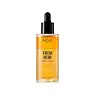What's inside
What's inside
 Key Ingredients
Key Ingredients

 Benefits
Benefits

 Concerns
Concerns

 Ingredients Side-by-side
Ingredients Side-by-side

Water
Skin ConditioningDipropylene Glycol
HumectantSalicylic Acid
MaskingPentylene Glycol
Skin ConditioningButylene Glycol
HumectantPolysorbate 20
EmulsifyingPalmitoyl Tripeptide-1
Skin ConditioningPalmitoyl Tetrapeptide-7
Skin ConditioningDipotassium Glycyrrhizate
HumectantNordihydroguaiaretic Acid
AntioxidantOleanolic Acid
Skin ConditioningSodium Hyaluronate
HumectantAllantoin
Skin ConditioningTrehalose
HumectantPanthenol
Skin ConditioningGlycerin
HumectantPEG-60 Almond Glycerides
EmulsifyingSodium Metabisulfite
AntioxidantPEG/PPG-17/6 Copolymer
SolventMethyl Gluceth-20
HumectantBis-PEG-18 Methyl Ether Dimethyl Silane
EmollientGlycereth-26
HumectantSodium Hydroxide
BufferingCarbomer
Emulsion StabilisingDisodium EDTA
Caprylyl Glycol
EmollientWater, Dipropylene Glycol, Salicylic Acid, Pentylene Glycol, Butylene Glycol, Polysorbate 20, Palmitoyl Tripeptide-1, Palmitoyl Tetrapeptide-7, Dipotassium Glycyrrhizate, Nordihydroguaiaretic Acid, Oleanolic Acid, Sodium Hyaluronate, Allantoin, Trehalose, Panthenol, Glycerin, PEG-60 Almond Glycerides, Sodium Metabisulfite, PEG/PPG-17/6 Copolymer, Methyl Gluceth-20, Bis-PEG-18 Methyl Ether Dimethyl Silane, Glycereth-26, Sodium Hydroxide, Carbomer, Disodium EDTA, Caprylyl Glycol
Water
Skin ConditioningMelia Azadirachta Flower Extract
Skin ConditioningCymbopogon Schoenanthus Extract
Skin ConditioningCurcuma Longa Root Extract
MaskingTocopheryl Acetate
AntioxidantDextrin
AbsorbentHydrogenated Polydecene
EmollientCitrus Aurantifolia Oil
CleansingOcimum Sanctum Leaf Extract
Skin ConditioningTheobroma Cacao Extract
Skin ConditioningGlycerin
HumectantNymphaea Alba Flower Extract
Skin ConditioningBetaine
HumectantCetyl Ethylhexanoate
EmollientCitrus Limon Peel Oil
MaskingMelia Azadirachta Leaf Extract
Skin ConditioningEclipta Prostrata Extract
Skin ConditioningMoringa Oleifera Seed Oil
EmollientCitrus Aurantium Dulcis Peel Oil
MaskingSodium Chloride
MaskingMentha Rotundifolia Leaf Extract
TonicEthylhexylglycerin
Skin ConditioningOcimum Basilicum Flower/Leaf Extract
TonicLimnanthes Alba Seed Oil
Skin ConditioningCamellia Japonica Flower Extract
EmollientAloe Barbadensis Leaf Water
MaskingMelia Azadirachta Bark Extract
AntimicrobialCoptis Japonica Root Extract
Skin ConditioningButylene Glycol
Humectant1,2-Hexanediol
Skin ConditioningPearl Powder
Citrus Aurantifolia Peel Extract
CleansingDisodium EDTA
Dipropylene Glycol
HumectantSodium Palmitoyl Proline
Skin ConditioningWater, Melia Azadirachta Flower Extract, Cymbopogon Schoenanthus Extract, Curcuma Longa Root Extract, Tocopheryl Acetate, Dextrin, Hydrogenated Polydecene, Citrus Aurantifolia Oil, Ocimum Sanctum Leaf Extract, Theobroma Cacao Extract, Glycerin, Nymphaea Alba Flower Extract, Betaine, Cetyl Ethylhexanoate, Citrus Limon Peel Oil, Melia Azadirachta Leaf Extract, Eclipta Prostrata Extract, Moringa Oleifera Seed Oil, Citrus Aurantium Dulcis Peel Oil, Sodium Chloride, Mentha Rotundifolia Leaf Extract, Ethylhexylglycerin, Ocimum Basilicum Flower/Leaf Extract, Limnanthes Alba Seed Oil, Camellia Japonica Flower Extract, Aloe Barbadensis Leaf Water, Melia Azadirachta Bark Extract, Coptis Japonica Root Extract, Butylene Glycol, 1,2-Hexanediol, Pearl Powder, Citrus Aurantifolia Peel Extract, Disodium EDTA, Dipropylene Glycol, Sodium Palmitoyl Proline
 Reviews
Reviews

Ingredients Explained
These ingredients are found in both products.
Ingredients higher up in an ingredient list are typically present in a larger amount.
Butylene Glycol (or BG) is used within cosmetic products for a few different reasons:
Overall, Butylene Glycol is a safe and well-rounded ingredient that works well with other ingredients.
Though this ingredient works well with most skin types, some people with sensitive skin may experience a reaction such as allergic rashes, closed comedones, or itchiness.
Learn more about Butylene GlycolDipropylene Glycol is a synthetically created humectant, stabilizer, and solvent.
This ingredient helps:
Dipropylene glycol is technically an alcohol, but it belongs to the glycol family (often considered part of the ‘good’ alcohols). This means it is hydrating and gentle on skin unlike drying solvent alcohols like denatured alcohol.
As a masking agent, Dipropylene Glycol can be used to cover the smell of other ingredients. However, it does not have a scent.
Studies show Dipropylene Glycol is considered safe to use in skincare.
Learn more about Dipropylene GlycolDisodium EDTA plays a role in making products more stable by aiding other preservatives.
It is a chelating agent, meaning it neutralizes metal ions that may be found in a product.
Disodium EDTA is a salt of edetic acid and is found to be safe in cosmetic ingredients.
Learn more about Disodium EDTAGlycerin is already naturally found in your skin. It helps moisturize and protect your skin.
A study from 2016 found glycerin to be more effective as a humectant than AHAs and hyaluronic acid.
As a humectant, it helps the skin stay hydrated by pulling moisture to your skin. The low molecular weight of glycerin allows it to pull moisture into the deeper layers of your skin.
Hydrated skin improves your skin barrier; Your skin barrier helps protect against irritants and bacteria.
Glycerin has also been found to have antimicrobial and antiviral properties. Due to these properties, glycerin is often used in wound and burn treatments.
In cosmetics, glycerin is usually derived from plants such as soybean or palm. However, it can also be sourced from animals, such as tallow or animal fat.
This ingredient is organic, colorless, odorless, and non-toxic.
Glycerin is the name for this ingredient in American English. British English uses Glycerol/Glycerine.
Learn more about GlycerinWater. It's the most common cosmetic ingredient of all. You'll usually see it at the top of ingredient lists, meaning that it makes up the largest part of the product.
So why is it so popular? Water most often acts as a solvent - this means that it helps dissolve other ingredients into the formulation.
You'll also recognize water as that liquid we all need to stay alive. If you see this, drink a glass of water. Stay hydrated!
Learn more about Water